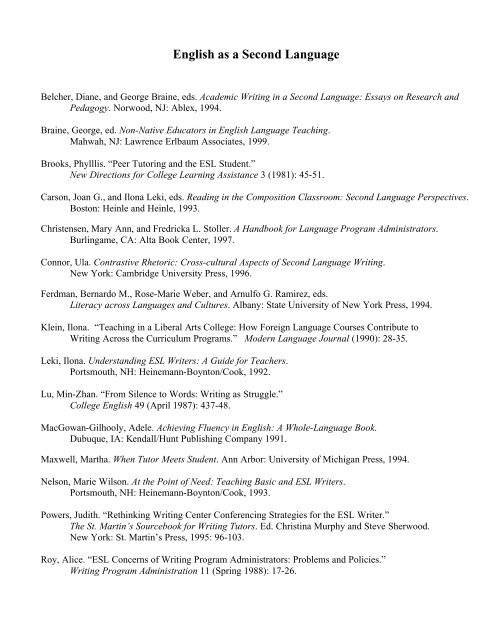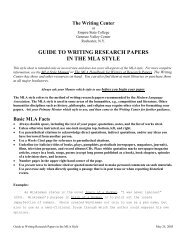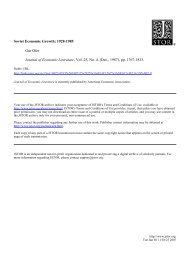English as a Second Language (PDF)
English as a Second Language (PDF)
English as a Second Language (PDF)
You also want an ePaper? Increase the reach of your titles
YUMPU automatically turns print PDFs into web optimized ePapers that Google loves.
<strong>English</strong> <strong>as</strong> a <strong>Second</strong> <strong>Language</strong>Belcher, Diane, and George Braine, eds. Academic Writing in a <strong>Second</strong> <strong>Language</strong>: Essays on Research andPedagogy. Norwood, NJ: Ablex, 1994.Braine, George, ed. Non-Native Educators in <strong>English</strong> <strong>Language</strong> Teaching.Mahwah, NJ: Lawrence Erlbaum Associates, 1999.Brooks, Phylllis. “Peer Tutoring and the ESL Student.”New Directions for College Learning Assistance 3 (1981): 45-51.Carson, Joan G., and Ilona Leki, eds. Reading in the Composition Cl<strong>as</strong>sroom: <strong>Second</strong> <strong>Language</strong> Perspectives.Boston: Heinle and Heinle, 1993.Christensen, Mary Ann, and Fredricka L. Stoller. A Handbook for <strong>Language</strong> Program Administrators.Burlingame, CA: Alta Book Center, 1997.Connor, Ula. Contr<strong>as</strong>tive Rhetoric: Cross-cultural Aspects of <strong>Second</strong> <strong>Language</strong> Writing.New York: Cambridge University Press, 1996.Ferdman, Bernardo M., Rose-Marie Weber, and Arnulfo G. Ramirez, eds.Literacy across <strong>Language</strong>s and Cultures. Albany: State University of New York Press, 1994.Klein, Ilona. “Teaching in a Liberal Arts College: How Foreign <strong>Language</strong> Courses Contribute toWriting Across the Curriculum Programs.” Modern <strong>Language</strong> Journal (1990): 28-35.Leki, Ilona. Understanding ESL Writers: A Guide for Teachers.Portsmouth, NH: Heinemann-Boynton/Cook, 1992.Lu, Min-Zhan. “From Silence to Words: Writing <strong>as</strong> Struggle.”College <strong>English</strong> 49 (April 1987): 437-48.MacGowan-Gilhooly, Adele. Achieving Fluency in <strong>English</strong>: A Whole-<strong>Language</strong> Book.Dubuque, IA: Kendall/Hunt Publishing Company 1991.Maxwell, Martha. When Tutor Meets Student. Ann Arbor: University of Michigan Press, 1994.Nelson, Marie Wilson. At the Point of Need: Teaching B<strong>as</strong>ic and ESL Writers.Portsmouth, NH: Heinemann-Boynton/Cook, 1993.Powers, Judith. “Rethinking Writing Center Conferencing Strategies for the ESL Writer.”The St. Martin’s Sourcebook for Writing Tutors. Ed. Christina Murphy and Steve Sherwood.New York: St. Martin’s Press, 1995: 96-103.Roy, Alice. “ESL Concerns of Writing Program Administrators: Problems and Policies.”Writing Program Administration 11 (Spring 1988): 17-26.
Silman, Anna, and Abigail Tom. Practical Resources for Adult ESL: A Selection Guide to Materials for AdultESL and ESL/ESOL Literacy. Burlingame, CA: Alta Book Center Publishers, 2000.Spack, Ruth. “The Acquisition of Academic Literacy in a <strong>Second</strong> <strong>Language</strong>: A Longitudinal C<strong>as</strong>e Study.”Written Communication 14.1 (January 1997): 3-62.Swan, Michael, and Bernard Smith, eds. Learner <strong>English</strong>: A Teacher's Guide toInterference and Other Problems. NewYork: Cambridge University Press, 1987.Tucker, Amy. Decoding ESL: International Students in the American College Cl<strong>as</strong>sroom.Portsmouth, NH: Heinemann-Boynton/Cook, 1995.Zamel, Vivian. “Strangers in Academia: The Experiences of Faculty and ESL Students across theCurriculum.” College Composition and Communication 46.4 (December 1995): 506-21.Zamel, Vivian, and Ruth Spack, eds. Negotiating Academic Literacies: Teaching and LearningAcross <strong>Language</strong>s and Cultures. Mahwah, NJ: Lawrence Erlbaum Associates, 1998.




